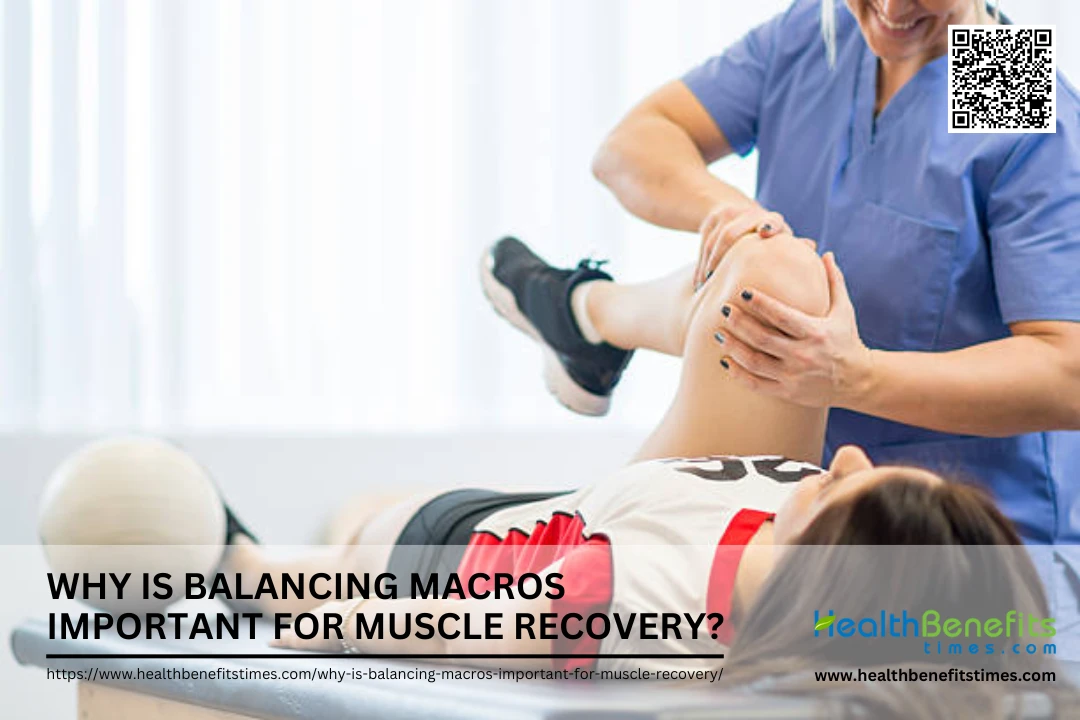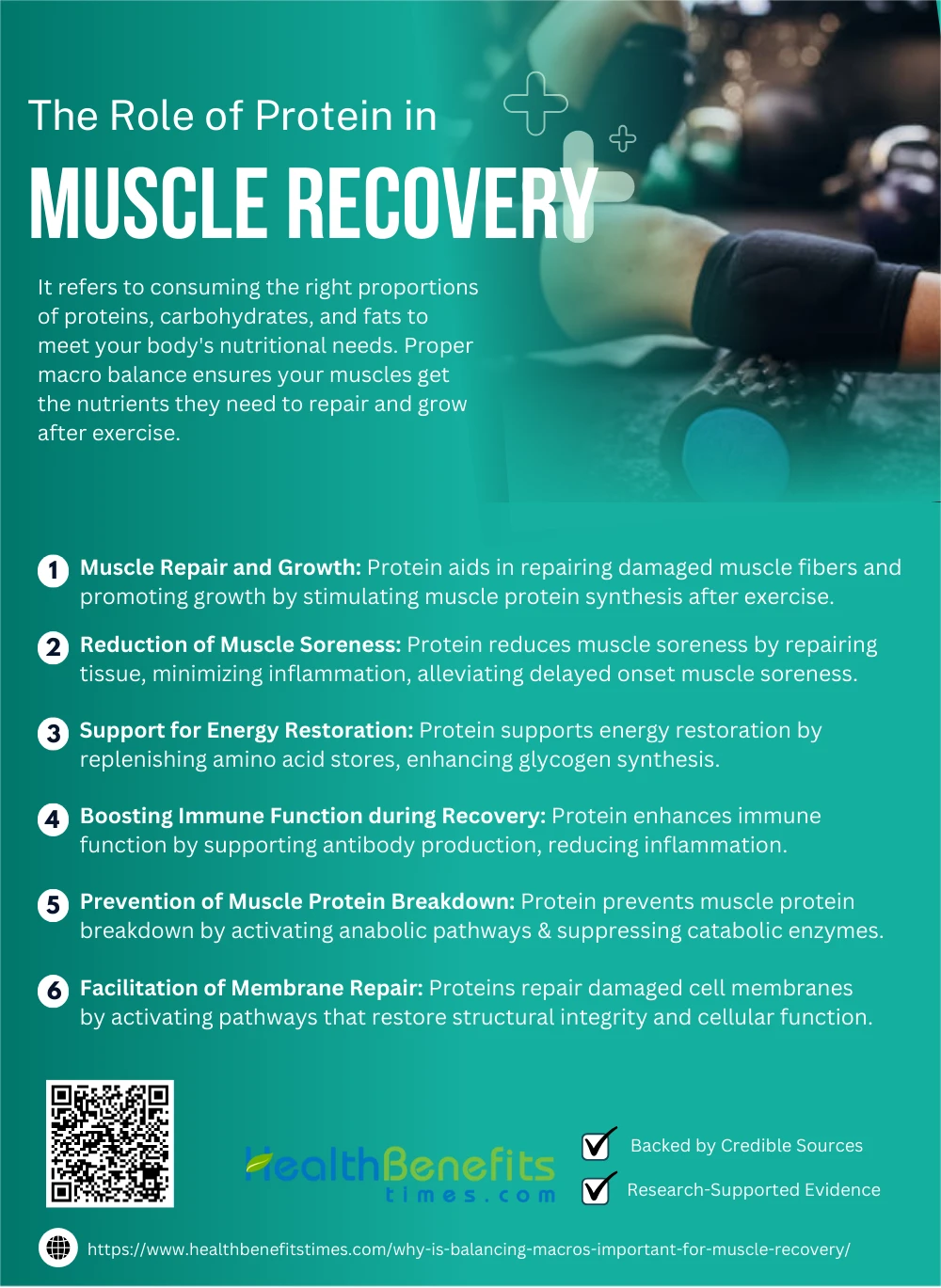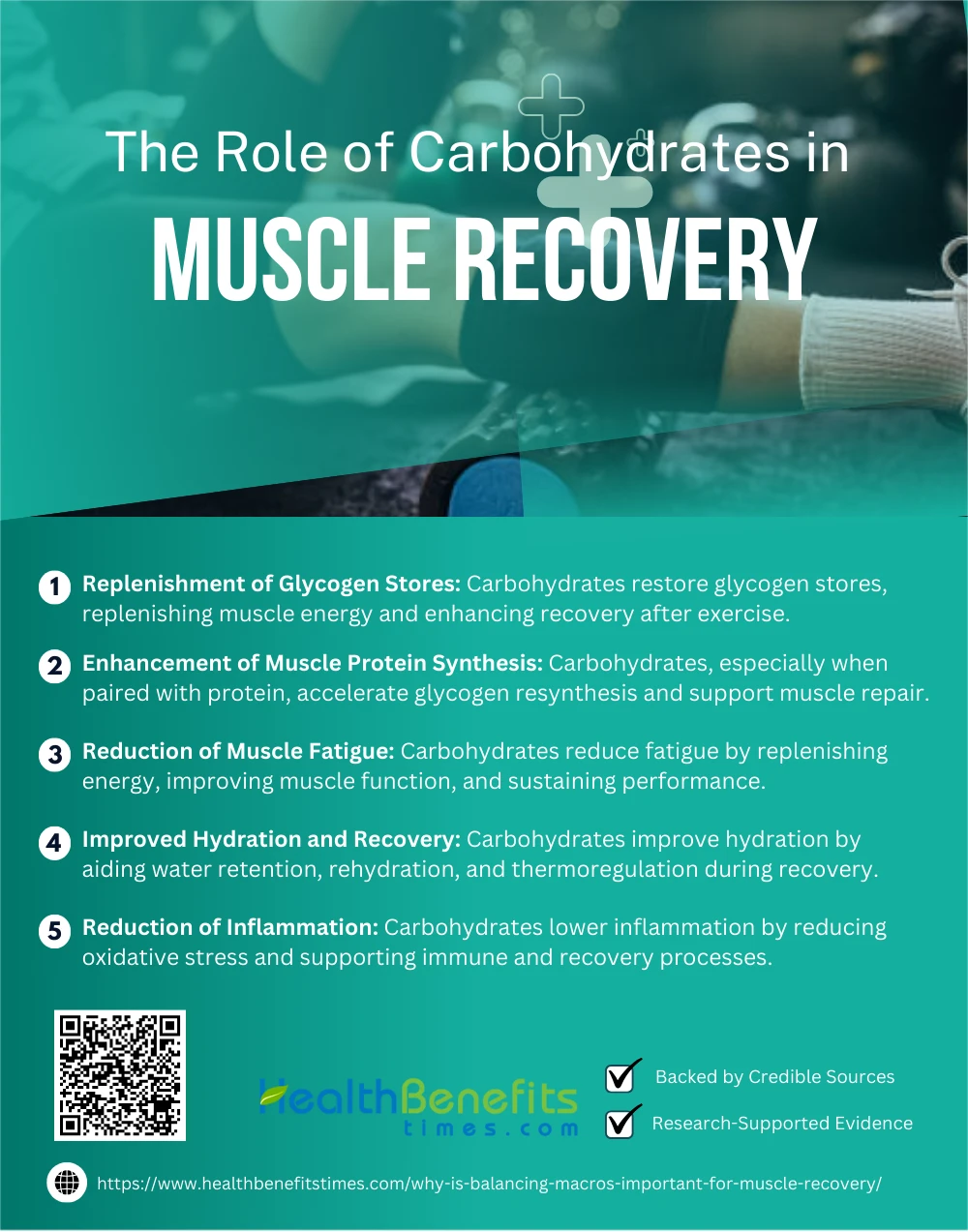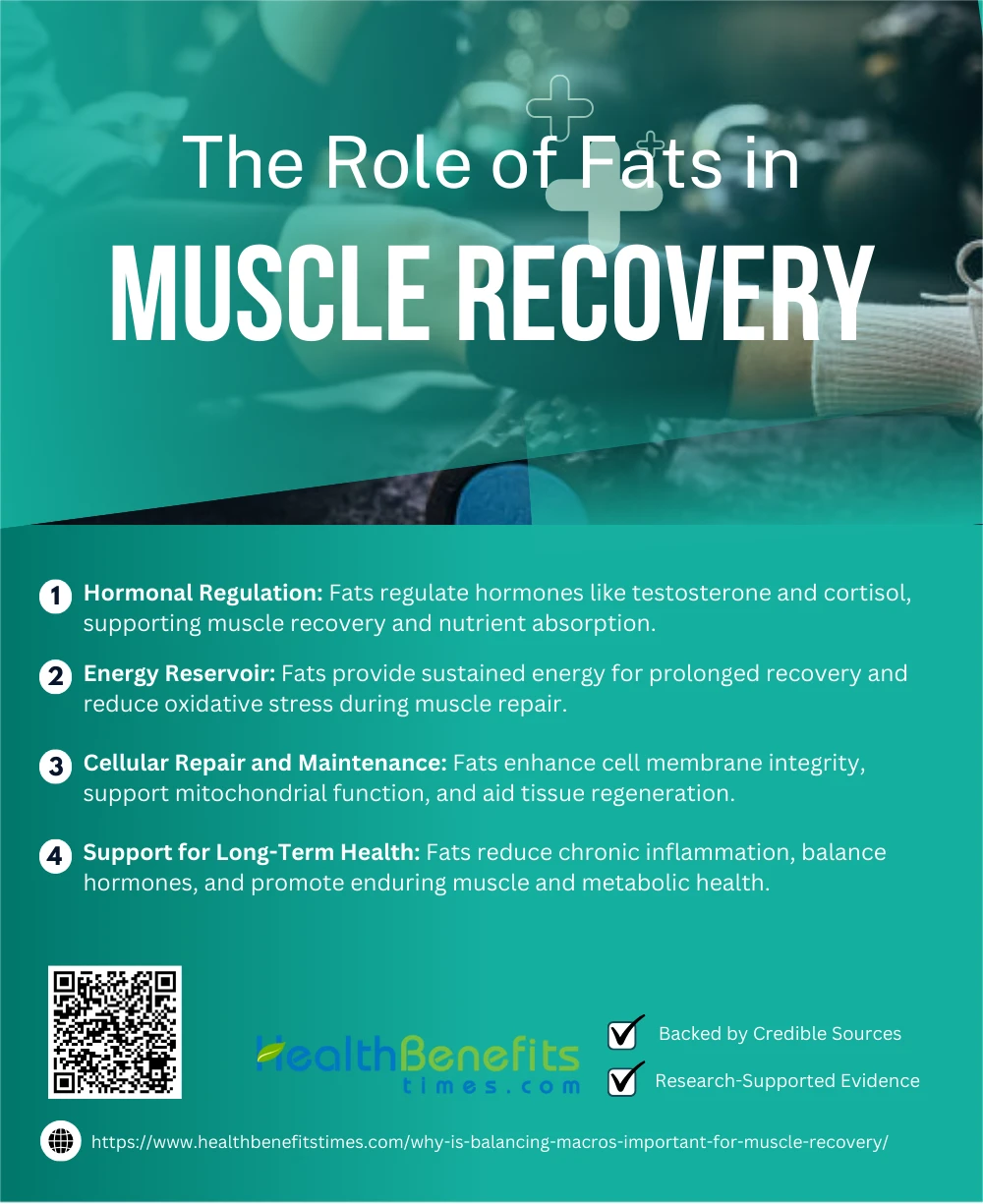- It refers to consuming the right proportions of proteins, carbohydrates, and fats to meet your body’s nutritional needs.
- Proper macro balance ensures your muscles get the nutrients they need to repair and grow after exercise.
- A well-balanced macro intake boosts energy levels, reduces fatigue, and optimizes overall physical performance.
 Balancing macros refers to the strategic allocation of macronutrients—proteins, carbohydrates, and fats—in one’s diet to support specific health and fitness goals, such as muscle recovery and energy optimization (1). Muscle recovery, essential for improving athletic performance and preventing injuries, heavily depends on a balanced intake of macronutrients. Proteins are vital for muscle repair and growth due to their amino acid content, which supports tissue regeneration (2). Carbohydrates replenish glycogen stores, providing the energy needed for recovery and reducing muscle fatigue (3). Additionally, fats, particularly omega-3 fatty acids, contribute to hormonal balance and minimize inflammation, enhancing recovery (4). Research also underscores the importance of meal timing and macro ratios for optimal recovery, emphasizing the synergistic effect of carbohydrates and proteins (5). Such balanced nutrition not only accelerates recovery but also reduces the risk of injuries and improves overall metabolic function (6).
Balancing macros refers to the strategic allocation of macronutrients—proteins, carbohydrates, and fats—in one’s diet to support specific health and fitness goals, such as muscle recovery and energy optimization (1). Muscle recovery, essential for improving athletic performance and preventing injuries, heavily depends on a balanced intake of macronutrients. Proteins are vital for muscle repair and growth due to their amino acid content, which supports tissue regeneration (2). Carbohydrates replenish glycogen stores, providing the energy needed for recovery and reducing muscle fatigue (3). Additionally, fats, particularly omega-3 fatty acids, contribute to hormonal balance and minimize inflammation, enhancing recovery (4). Research also underscores the importance of meal timing and macro ratios for optimal recovery, emphasizing the synergistic effect of carbohydrates and proteins (5). Such balanced nutrition not only accelerates recovery but also reduces the risk of injuries and improves overall metabolic function (6).
Athletes and fitness enthusiasts can greatly benefit from adopting macro-balanced diets, as evidenced by studies highlighting the integration of nutrition with training regimens for enhanced muscle recovery and sustained performance (7). By understanding and applying these principles, individuals can harness the full potential of their physical capabilities while promoting long-term health (8).
Understanding Macronutrients
Macronutrients—proteins, carbohydrates, and fats—are the essential building blocks of a healthy diet, providing energy and supporting bodily functions. Proteins are critical for tissue repair and immune function, making them indispensable for overall health (9). Carbohydrates act as the body’s primary energy source, particularly for brain and muscle activity (10). Fats, often misunderstood, are necessary for hormone production and cellular health (11). A proper balance of macronutrients ensures optimal energy levels, enhances metabolism, and supports long-term well-being (12). Understanding these roles is critical for informed dietary choices (13).
The Role of Protein in Muscle Recovery
Protein plays a crucial role in muscle recovery by providing the building blocks—amino acids—needed to repair and rebuild damaged muscle fibers. Consuming adequate protein after exercise helps stimulate muscle protein synthesis (MPS), reduce soreness, and promote faster recovery, making it an essential component of any fitness routine.
 1. Muscle Repair and Growth
1. Muscle Repair and Growth
Protein is essential for repairing damaged muscle fibers and promoting growth by activating muscle protein synthesis pathways (14). It reduces muscle damage, enhances recovery, and facilitates growth when consumed post-exercise (15). Supplements like whey protein optimize recovery by providing essential amino acids (16). Combining protein with physical training amplifies these effects (17). Such strategies are vital for improving performance and maintaining muscle mass (18).
2. Reduction of Muscle Soreness
Protein reduces muscle soreness by facilitating tissue repair and reducing inflammation. Post-exercise protein intake enhances recovery, alleviating delayed onset muscle soreness (DOMS) through decreased muscle damage (19). Supplements like β-hydroxy-β-methylbutyrate (HMB) further minimize muscle soreness by reducing protein breakdown (18). Protein also regulates inflammatory markers, speeding recovery (20). Plant-based proteins similarly aid in reducing soreness (17). Targeted protein-rich diets optimize muscle recovery and prevent prolonged soreness (21).
3. Support for Energy Restoration
Protein plays a pivotal role in energy restoration by replenishing amino acid stores, vital for cellular energy metabolism (22). Post-exercise protein intake facilitates glycogen synthesis, enhancing recovery and energy levels (23). Proteins also prevent energy depletion by maintaining lean body mass (24). High-protein diets improve mitochondrial function, supporting sustained energy production (25). Additionally, proteins act as a backup energy source during caloric deficits (26).
4. Boosting Immune Function during Recovery
Protein enhances immune function during recovery by providing essential amino acids for antibody production and cellular repair (27). It modulates immune responses, reducing inflammation and promoting faster healing (28). Proteins also stimulate T-cell production, strengthening the body’s defenses (29). During infection recovery, proteins like albumin restore cellular energy and support metabolic demands (30). Finally, protein aids in the activation of signaling pathways critical to immune regulation (31).
5. Prevention of Muscle Protein Breakdown
Protein prevents muscle protein breakdown by promoting muscle protein synthesis and inhibiting catabolic pathways. It provides essential amino acids that suppress proteolytic enzymes, maintaining muscle mass during stress or inactivity (32). High-protein diets stimulate anabolic signaling pathways like mTOR, crucial for muscle preservation (33). Supplements like HMB further enhance these effects by reducing muscle degradation (18). Adequate protein intake is particularly vital in aging populations to combat sarcopenia (34).
6. Facilitation of Membrane Repair
Proteins play a critical role in repairing damaged cell membranes by activating pathways that restore structural integrity and cellular function. Dysferlin, a key membrane protein, aids in sealing ruptures caused by mechanical stress (35). MG53 protein enhances repair by modulating vesicle trafficking and calcium signaling (36). Additionally, specialized proteins regulate mitochondrial bioenergetics to support repair processes (37). Laminin 332 facilitates repair by promoting cell adhesion and proliferation on damaged surfaces (38). These mechanisms are vital for maintaining cellular homeostasis.
The Role of Carbohydrates in Muscle Recovery
Carbohydrates are vital for muscle recovery as they replenish glycogen stores depleted during exercise. This process restores energy levels, reduces fatigue, and supports the body’s ability to recover effectively. Consuming carbs post-workout enhances recovery by facilitating faster glycogen re-synthesis, especially when paired with protein, making it an essential component of any recovery plan.
 1. Replenishment of Glycogen Stores
1. Replenishment of Glycogen Stores
Replenishing glycogen stores post-exercise is crucial for restoring muscle energy and improving recovery. Carbohydrates play a central role in refilling depleted glycogen, optimizing endurance and performance (39). Combined carbohydrate-protein intake accelerates glycogen resynthesis (40). Glycogen restoration supports faster recovery in muscle tissue, especially under high-intensity exercise conditions (41). Efficient glycogen recovery minimizes fatigue and prepares the body for subsequent activity (42).
2. Enhancement of Muscle Protein Synthesis
Replenishing glycogen stores post-exercise is crucial for restoring muscle energy and improving recovery. Carbohydrates play a central role in refilling depleted glycogen, optimizing endurance and performance (39). Combined carbohydrate-protein intake accelerates glycogen resynthesis (40). Glycogen restoration supports faster recovery in muscle tissue, especially under high-intensity exercise conditions (41). Efficient glycogen recovery minimizes fatigue and prepares the body for subsequent activity (42).
3. Reduction of Muscle Fatigue
Carbohydrates reduce muscle fatigue by replenishing glycogen stores, providing energy for sustained performance. This process improves muscle function, enabling quicker recovery after intense exercise (43). Carbohydrate-protein combinations significantly decrease oxidative stress and fatigue levels (44). Additionally, they enhance endurance by minimizing central and peripheral fatigue (45). Proper carbohydrate intake ensures stable energy levels during recovery, supporting overall muscle repair (19).
4. Improved Hydration and Recovery
Carbohydrates enhance hydration by aiding water retention during recovery, preventing dehydration and electrolyte imbalances. This synergistic effect accelerates muscle repair and improves recovery outcomes (39). Combining carbohydrates with proteins boosts glycogen storage and rehydration efficacy (46). This process also supports thermoregulation during intense activity (47). Strategic carbohydrate intake minimizes recovery time and optimizes performance (19).
5. Reduction of Inflammation
Carbohydrates help reduce inflammation by modulating oxidative stress markers, accelerating muscle recovery. A carbohydrate-protein combination is particularly effective in lowering inflammatory cytokine levels (48). Strategic carbohydrate intake reduces post-exercise muscle soreness and enhances repair mechanisms (43). Additionally, it supports the immune response, mitigating chronic inflammation in athletes (8). Timely carbohydrate consumption optimizes anti-inflammatory pathways, facilitating recovery (19).
The Role of Fats in Muscle Recovery
Fats play a supportive role in muscle recovery by aiding hormone production, reducing inflammation, and providing sustained energy. Healthy fats, such as omega-3 fatty acids, can help decrease muscle soreness and promote cellular repair. Including adequate fats in your diet ensures a well-rounded recovery process, complementing the roles of protein and carbohydrates.
 1. Hormonal Regulation
1. Hormonal Regulation
Fats are crucial for hormonal regulation, facilitating the production of testosterone and cortisol, which are vital for muscle recovery and repair (3). Omega-3 fatty acids reduce stress-induced hormonal imbalances, supporting recovery (49). Fats also influence insulin sensitivity, optimizing nutrient absorption and energy use (50). Proper fat intake enhances the endocrine system, ensuring long-term muscle function (8).
2. Energy Reservoir
Fats serve as a dense energy reservoir, sustaining long-duration recovery processes and optimizing performance post-exercise (51). Adipose tissue releases fatty acids that fuel prolonged muscle activity (52). Fats enhance energy efficiency, reducing oxidative stress during intense recovery (53). This lipid metabolism contributes to consistent energy availability for muscle repair (54).
3. Cellular Repair and Maintenance
Fats contribute to cellular repair by supporting the integrity of cell membranes, particularly during muscle recovery. Omega-3 fatty acids enhance membrane fluidity and facilitate nutrient transport (55). Lipids also regulate mitochondrial function, which is vital for energy production during repair processes (56). Furthermore, fats promote the synthesis of phospholipids, essential for maintaining structural stability in muscle cells (53). Proper dietary fat intake accelerates tissue regeneration and recovery (54).
4. Support for Long-Term Health
Fats play a vital role in promoting long-term muscle health by modulating inflammation and improving cellular resilience (19). Omega-3 fatty acids enhance recovery and reduce chronic inflammatory markers, ensuring sustained muscle function (57). Additionally, dietary fats support hormonal balance, essential for metabolic health and tissue repair (56). A balanced fat intake contributes to overall endurance and reduces the risk of degenerative conditions (54).
Consequences of Imbalanced Macronutrient Intake
Imbalanced macronutrient intake can hinder muscle recovery and overall performance. Consuming too much protein without sufficient carbs may lead to energy deficits, while excessive fats or carbs without enough protein can delay muscle repair. A lack of healthy fats might disrupt hormonal balance and prolong inflammation. Ensuring a proper macronutrient balance is crucial for optimizing recovery and maintaining long-term health.
1. Weight Gain and Obesity
Imbalanced macronutrient intake, particularly excessive fat and carbohydrate consumption, leads to energy surplus, promoting weight gain and obesity (58). High sugar diets contribute to fat storage and metabolic inefficiency (59). Additionally, inadequate fiber intake exacerbates this imbalance (60). Poor dietary patterns further increase obesity risks in adolescents (61).
2. Muscle Loss and Weakness
Imbalanced macronutrient intake, particularly low protein levels, leads to muscle loss and functional weakness, exacerbated by prolonged malnutrition (62). Insufficient nutrient intake impairs muscle synthesis, worsening sarcopenia in aging populations (63). High-fat, low-protein diets disrupt anabolic processes essential for maintaining strength (64). Macronutrient imbalance in dystrophy patients magnifies weakness and atrophy (65).
3. Chronic Diseases
Imbalanced macronutrient intake contributes to the development of chronic diseases such as diabetes, cardiovascular disorders, and obesity. Excessive carbohydrate and fat consumption disrupt metabolic balance (66). Low-quality dietary patterns increase inflammatory markers and oxidative stress (67). Inadequate protein intake impairs muscle and organ function, worsening chronic disease progression (58). Balanced nutrition reduces risks and enhances long-term health (68).
4. Metabolic Disorders
Imbalanced macronutrient intake disrupts metabolic processes, contributing to conditions like metabolic syndrome and insulin resistance (69). Excessive carbohydrate consumption raises triglyceride levels, exacerbating diabetes risk (59). Protein deficiencies impair mitochondrial function, affecting energy metabolism (70). Long-term imbalances in macronutrient intake escalate chronic metabolic disorders (71).
8. Inflammation and Oxidative Stress
Imbalanced macronutrient intake triggers oxidative stress and chronic inflammation, disrupting cellular health and recovery processes (72). High-fat diets amplify inflammatory markers, elevating chronic disease risks (73). Excess carbohydrates exacerbate insulin resistance, intensifying oxidative damage (74). Nutritional balance reduces systemic inflammation and oxidative stress, enhancing metabolic health (75).
9. Micronutrient Deficiencies
Imbalanced macronutrient intake often results in insufficient absorption of vital micronutrients, impairing immune function and overall health (76). High-fat diets can hinder vitamin D utilization, while excessive carbohydrates diminish magnesium levels (66). Protein deficiencies reduce iron and zinc uptake, further exacerbating deficiencies (77). Addressing macronutrient balance is key to preventing these issues (78).
10. Hormonal Imbalances
Imbalanced macronutrient intake, particularly excessive fat or low protein diets, disrupts hormone production, leading to imbalances like insulin resistance and cortisol elevation (79). Chronic nutrient imbalances impair reproductive hormones, affecting fertility (71). Deficiencies in essential fatty acids reduce thyroid hormone function, impacting metabolism (77). Addressing macronutrient proportions restores hormonal equilibrium, enhancing health outcomes (78).
11. Reduced Physical Performance
Imbalanced macronutrient intake diminishes physical performance by depleting glycogen stores and reducing energy availability (79). Low carbohydrate diets impair endurance and recovery, limiting athletic output (66). Protein deficiencies hinder muscle repair, exacerbating fatigue (80). Excessive fat consumption contributes to metabolic inefficiency, reducing exercise capacity (77).
Practical Tips for Balancing Macros
- Track Your Macronutrient Intake: Consistently track your macronutrient consumption using apps, food diaries, or wearable devices. Monitoring helps identify areas for improvement and ensures you meet daily macronutrient needs tailored to your fitness or health goals.
- Prioritize Whole Foods: Incorporate unprocessed, nutrient-dense foods into your diet. Foods like lean meats, vegetables, fruits, and whole grains naturally provide balanced macronutrient ratios and improve nutrient absorption, promoting overall health.
- Customize Your Diet: Adjust macronutrient ratios according to your individual needs, whether it’s for weight loss, muscle building, or maintaining energy. For instance, increase protein for muscle growth or adjust fats and carbs for endurance.
- Combine Macronutrients in Meals: Design meals that contain a balance of carbohydrates, proteins, and fats. For instance, pair a protein source like chicken with a healthy fat such as avocado and a carbohydrate like quinoa to ensure a sustained release of energy.
- Adjust Portions Based on Activity Level: Modify macronutrient intake to reflect your physical activity. Increase carbohydrates for endurance activities and protein for post-exercise muscle repair. This approach enhances performance and recovery.
- Incorporate Healthy Fats: Include sources of healthy fats such as nuts, seeds, and fatty fish. These provide omega-3 fatty acids, which are critical for reducing inflammation and supporting heart health.
- Avoid Extreme Diets: Steer clear of fad diets that eliminate or overemphasize specific macronutrients. Such diets can lead to nutrient deficiencies and disrupt metabolic balance, harming long-term health.
- Educate Yourself: Learn about macronutrients’ roles and benefits to make informed dietary choices. Understand how proteins, fats, and carbohydrates work together to fuel your body and enhance performance.
Common Misconceptions about Macros and Recovery
- “High Protein Alone is Enough for Recovery”: Relying solely on protein overlooks the critical roles of carbohydrates in glycogen replenishment and fats in inflammation reduction, which together enhance overall recovery and performance.
- “Fats Should Be Avoided for Better Recovery”: Misconceptions around fats lead to avoidance, but healthy fats like omega-3s are essential for reducing inflammation, supporting cell repair, and maintaining hormonal balance during recovery.
- “Carbs Are Only Necessary for Endurance Athletes”: Carbs are often dismissed outside endurance sports, but they are crucial for replenishing glycogen stores, which fuel muscles for all types of physical activity.
- “Timing Doesn’t Matter”: Some believe macronutrient timing is insignificant, but strategic intake of proteins and carbs post-exercise accelerates muscle repair and glycogen restoration.
- “One Macro Fits All Recovery Goals”: A one-size-fits-all macronutrient ratio fails to address varying needs based on activity type, intensity, and individual goals such as muscle gain or weight management.
- “Macros Alone Ensure Full Recovery”: Focusing solely on macronutrients neglects the importance of hydration, micronutrients, and adequate rest, all of which are integral to effective recovery.
- “Supplements Are Superior to Whole Foods”: Supplements are often perceived as better alternatives, but whole foods provide comprehensive nutrients and bioavailability that synthetic supplements cannot fully replicate.
- “Fewer Calories Equal Better Recovery”: Cutting calories to speed recovery actually limits macronutrient availability, slowing repair processes and increasing fatigue.
Conclusion
Balancing macronutrients is essential for effective muscle recovery, as each macro plays a distinct and complementary role. Protein supports muscle repair and growth, carbohydrates replenish energy stores and reduce fatigue, and fats aid hormonal balance and reduce inflammation. An imbalance can compromise recovery, leading to prolonged soreness, reduced performance, and hindered progress. By tailoring your macronutrient intake to your activity level and goals, you can optimize recovery and sustain long-term health and fitness.
References:
- Forelli, F., et al. (2024). Stay in the Game: Comprehensive Approaches to Decrease the Risk of Sports Injuries. Cureus.
- Pramod, N., et al. (2024). Development and Standardization of Protein Mix Products for Enhancing Nutritional Recovery and Performance. ResearchGate.
- Mishra, S., et al. (2024). Beyond Calories: Exploring the Multifaceted Effects of a Balanced Diet on Disease-Related Biochemical and Physical Metrics. Debra College.
- Chodkowski, J. (2024). The Role of Nutrition and Hydration in Injury Prevention and Recovery. Journal of Education, Health and Sport.
- Dvořák, K. (2024). Nutritional Strategies and their Role in Enhancing Athletic Stamina. Revista de Psicología del Deporte.
- Purwanto, S., et al. (2024). Sports Nutrition and Gross Motor Skill Development in Youth Athletes. Jurnal Penelitian Pendidikan IPA.
- Vrdoljak, J. (2024). Važnost prehrane za uspjeh u nogometu. Repozitorij KIFST.
- Ihsan, F., et al. (2024). Nutritional Strategies for Rapid Recovery in Sport. Dialnet.
- Šoher, L., et al. (2024). Macronutrient Intake and Food Categories’ Contribution to Daily Energy Intake. Nutrients.
- Jagim, A. R., et al. (2024). Nutrition Knowledge and Perceived Dietary Requirements of Adolescent Student-Athletes. Nutrients.
- Zeng, L., et al. (2024). Speciation and Aqueous Dissolution of Macronutrients in Fire Ash. ACS Publications.
- Amalia, R. (2024). Balancing Tradition and Nutrition. Nutrition Reviews.
- Nambassa, W. (2024). Prevalence of Dietary Adherence and Associated Factors. Makerere University Repository.
- Nameni, F., et al. (2024). Response of Liver Enzymes to Whey Protein. Jorjani Biomedicine Journal.
- Nabiev, S. R., et al. (2024). Calcium and Muscle Contraction. International Journal of Molecular Sciences.
- Du, P., et al. (2024). FKBP5 and Muscle Recovery. Poultry Science.
- Aslan, Y. E., et al. (2024). Role of Protein Supplements in Recovery. IJPANH.
- Rathmacher, J. A., et al. (2025). HMB and Muscle Recovery. Journal of the International Society of Sports Nutrition.
- López-Samanes, A., et al. (2024). Nutrition for Team and Individual Sport Athletes. Frontiers in Sports and Active Living.
- Collier-Bain, H. D., et al. (2024). DOMS and Protein Intake. Scientific Reports.
- Zhao, L., et al. (2025). Protein and Muscle Recovery. Chinese Journal of Tissue Engineering Research.
- Sugishita, Y., et al. (2024). The Role of Protein in Longevity and Energy Restoration.
- Fernández-Elías, V. E., et al. (2024). Gender Differences in Nutritional Needs for Recovery.
- Fiaccadori, E., et al. (2024). Protein Needs in Critical Care. Clinical Nutrition ESPEN.
- Kollipara, L., et al. (2024). Protein and Mitochondrial Energy Production. Frontiers in Immunology.
- Kiage, B. N. (2024). Nutritional Impact on Recovery. Kenyatta University Repository.
- Sabbatini, S., et al. (2024). Modulation of Immune Response in Recovery.
- Gunasena, M. G. B. (2024). Immune Response and Protein Role. OhioLINK ETD.
- Forcade, E., et al. (2024). Enhancing T-cell Production Post-Recovery.
- Naik, R. A., et al. (2025). Albumin and Cellular Repair. A New Era in Recovery.
- Xu, Y., et al. (2024). Protein Activation in Immune Pathways.
- Wang, S., et al. (2024). Inhibiting Muscle Degradation via FTO and Pathways. Journal of Advanced Research.
- Calabrese, F. M., et al. (2024). Role of Protein in Obesity and Muscle Health.
- Park, J., et al. (2024). Protein’s Role in Preventing Sarcopenia. Journal of Medicinal Food.
- Lv, N., et al. (2024). Dysferlin and Membrane Repair Pathways. Materials Today Bio.
- Wu, J., et al. (2024). Role of MG53 in Membrane Repair. International Journal of Molecular Sciences.
- Ahola, S. (2024). Mitochondrial Bioenergetics in Repair Processes. Frontiers in Molecular Biosciences.
- Perdomo, S. J., et al. (2024). Laminin 332 in Cellular Repair.
- Jurek, J. M. (2024). Dietary Approaches in Endurance Athletes with Diabetes. Case Reports Review Open Access.
- Tarmast, D. (2024). Effect of Carbohydrate, Protein, and Their Combined Supplementation on Cycling Performance. Journal of Sports Physiology and Athletic Conditioning.
- McClelland, G. B., et al. (2024). Metabolic Recovery from Submaximal Exercise. Comparative Biochemistry and Physiology.
- Batt, M. C., et al. (2024). Glycogen Metabolism in Skeletal Muscle Recovery. Journal of Animal Science.
- Tarmast, D., & Ghosh, A. K. (2024). Impact of Carbohydrate, Protein, and Combined Supplementation. Asian Journal of Sports Medicine.
- Vigh-Larsen, J. F., et al. (2024). Fatiguing High-Intensity Exercise and Recovery. European Journal of Applied Physiology.
- Geddes, X., et al. (2024). Muscle Strength, Power, and Recovery in Space.
- Wang, L., et al. (2024). Post-Exercise Recovery Nutrition.
- Tovar Mejía, M. S. (2024). Thermoregulation and Hydration in Athletes. Repositorio UTA.
- Pojednic, R., et al. (2024). Dietary Supplementation and Recovery in Military Personnel.
- Nakagawa, T., et al. (2024). Plasticity of Bone Marrow-Derived Cell Differentiation. Frontiers in Physiology.
- Kumarachari, R., et al. (2024). Introduction to Nutrition and Autoimmune Diseases. IGI Global.
- Décombaz, J. (2003). Nutrition and Recovery of Muscle Energy Stores After Exercise. Schweizerische Zeitschrift fur Sportmedizin und Sporttraumatologie.
- Rezaee, F., & Dashty, M. (2013). Role of Adipose Tissue in Metabolic System Disorders. Journal of Diabetes & Metabolism.
- Sayiner, S. (2024). Energy Efficiency in Muscle Recovery. Biochemistry Insights.
- Kerksick, C. M. (2019). Requirements of Proteins, Carbohydrates, and Fats for Athletes. The Health Sciences Academy.
- Mantri, M., et al. (2024). Villus Myofibroblasts and Dietary Fats. Developmental Cell.
- Wallace, D. C. (2009). Mitochondria, Bioenergetics, and the Epigenome. Cold Spring Harbor Symposia on Quantitative Biology.
- Agostoni, C., & Giannì, M. L. (2024). Body Composition Assessment in Preterm Infants. Pediatric Research.
- Esparza, W. B. G., et al. (2024). Health Science. Atena Editora.
- Gagliardino, J. J., et al. (2024). Nutrición Humana y Dietética. Revista Española de Nutrición Humana y Dietética.
- Simbolon, D. (2024). Macronutrient Intake and Obesity in Adolescents. National Nutrition Journal.
- Ceylan, H. İ., et al. (2024). Poor Eating Habits and Low Physical Activity.
- Kiani, A. K., et al. (2022). Main Nutritional Deficiencies. Journal of Preventive Medicine.
- Welch, A. A. (2014). Nutritional Influences on Age-Related Skeletal Muscle Loss. Proceedings of the Nutrition Society.
- Tateishi, Y., et al. (2023). Effect of Imbalance in Dietary Macronutrients. Frontiers in Nutrition.
- Motlagh, B., et al. (2005). Nutritional Inadequacy in Adults with Muscular Dystrophy. Muscle & Nerve.
- Carretero-Krug, A., et al. (2024). Dietary Nutrient Adequacy and Chronic Disease Risks.
- Fitriani, F., et al. (2024). Nutritional Intake and Chronic Diseases. European Journal of Medical and Health Sciences.
- Paul, S. (2024). Potassium and Macronutrient Balance. Krishikosh
- Rathia, S. K., et al. (2024). Management of Severe Acute Malnutrition. Contusm Publications.
- Kotarsky, C. J., et al. (2024). Macronutrient Imbalance and Metabolism.
- Arifin, A. D. R., et al. (2024). Dietary Substitution and Metabolic Disorders. INSOLOGI: Jurnal Sains.
- Ruiz-Núñez, B., et al. (2013). Nutritional Imbalances and Chronic Inflammation. The Journal of Nutritional Biochemistry.
- Francisqueti, F. V., et al. (2017). Oxidative Stress in Metabolic Syndrome. Revista da Associação Médica Brasileira.
- Fisher-Wellman, K., & Bloomer, R. J. (2009). Macronutrient-Specific Oxidative Stress. Current Diabetes Reviews.
- Manna, P., & Jain, S. K. (2015). Oxidative Stress and Adipose Dysfunction. Metabolic Syndrome and Related Disorders.
- Rousseau, A. F., et al. (2024). Nutritional Approach for Patients with Minor Burns. Journal of Parenteral and Enteral Nutrition.
- Boutata, F. Z., et al. (2024). Guidelines on Hospital Nutrition. Nutrition Clinique et Métabolisme.
- Mujayanto, M., & Pratiwi, E. R. (2024). Correlation Between Macronutrient Imbalance and Micronutrient Deficiency. Airlangga Medical Nutrition Technology Journal.
- Aguilera-González, C. J., et al. (2024). Dietary Intake and Hormonal Changes.
- Sadeghi, M., et al. (2024). Dietary Composition Effects on Performance. Journal of Dairy Science.


